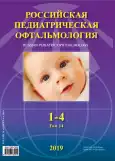Postnatal risk factors of type 1 retinopathy of prematurity in children with a gestational age less than 27 weeks
- Authors: Saidasheva E.I.1,2, Buyanovskaya S.V.1,2, Kovshov F.V.2
-
Affiliations:
- North-Western State Medical University named after I.I. Mechnikov
- Children’s city multidisciplinary clinical specialized center for high medical technologies
- Issue: Vol 14, No 1 (2019)
- Pages: 5-11
- Section: Clinical studies
- URL: https://journals.rcsi.science/1993-1859/article/view/56962
- DOI: https://doi.org/10.17816/1993-1859-2019-14-1-4-5-11
- ID: 56962
Cite item
Full Text
Abstract
Aim: The aim of this study is to determine the prognostic significance of postnatal risk factors for Type 1 retinopathy of prematurity (ROP) in children born before 27 weeks of gestation.
Materials and methods: From 2009 to 2014, we observed 239 patients with gestational age (GA) of 22–26 weeks (average, 24.9 ± 1.0 weeks) and birth weight of 490–1200 g (average, 776.9 ± 140.1 g), who subsequently developed ROP. Depending on the stage of active ROP, the children were divided into four groups: group 1 included 83 children with stage 1 of ROP, group 2 included 70 children with stage 2 of ROP, group 3 included 57 newborns with stage 3 of ROP plus disease (threshold), and group 4 consisted of 29 patients with aggressive posterior ROP. Thus, 86 (36%) children in groups 3 and 4 had an unfavorable course — Type 1 ROP. Screening and monitoring of the disease were performed in accordance with federal clinical guidelines.
Results: The development of severe stages of ROP correlated with a decrease in the mean gestational age (p = 0.0002) and birth weight (p = 0.0006). Fifteen risk factors that are associated with the somatic condition of patients with gestational age less than 27 weeks in the postnatal period were studied. The reliability of their significance in the development of Type 1 ROP was determined by the length of stay on mechanical ventilation (more than 45 days), multiple blood transfusions (more than 6), and early surgical treatment of an open ductus arteriosus.
Conclusion: Consideration and correction of identified postnatal risk factors for the development of Type 1 ROP will enable timely prediction and minimize the likelihood of an adverse course of the disease. Therefore, improving the organization and quality of neonatal care for children with gestational age less than 27 weeks could prevent the development of severe forms of ROP.
Full Text
##article.viewOnOriginalSite##About the authors
Elvira I. Saidasheva
North-Western State Medical University named after I.I. Mechnikov; Children’s city multidisciplinary clinical specialized center for high medical technologies
Author for correspondence.
Email: esaidasheva@mail.ru
ORCID iD: 0000-0003-4012-7324
MD, PhD, Professor
Russian Federation, 191015, Saint Petersburg; 198205, Saint PetersburgSvetlana V. Buyanovskaya
North-Western State Medical University named after I.I. Mechnikov; Children’s city multidisciplinary clinical specialized center for high medical technologies
Email: esaidasheva@mail.ru
ORCID iD: 0000-0001-7503-2611
MD
Russian Federation, 191015, Saint Petersburg; 198205, Saint Petersburg
Fedor V. Kovshov
Children’s city multidisciplinary clinical specialized center for high medical technologies
Email: esaidasheva@mail.ru
ORCID iD: 0000-0001-6039-1398
MD
Russian Federation, 198205, Saint PetersburgReferences
- Austeng D. Retinopathy of Prematurity in infants born before 27 weeks of gestation (A National Population-based Study in Sweden During 2004–2007). Uppsala: Acta Universitatis Upsaliensis; 2010.
- Katargina LA. Retinopathy of premature babies, the current state of the problem and tasks of organizing ophthalmological care for premature babies in the Russian Federation. Russian Pediatric Ophthalmology. 2012;(1):5-7. (in Russian)
- Fierson WM. Screening examination of premature infants for retinopathy of prematurity (American Academy of Ophthalmology). Pediatrics. 2013;131(1):189-95. doi: 10.1542/peds.2012-2996.
- Holmström G, Hellström A, Jakobsson P, et al. Five years of treatment for retinopathy of prematurity in Sweden: results from SWEDROP, a national quality register. Br. J. Ophthalmol. 2016;100(12):1656-61. doi: 10.1136/bjophthalmol-2015-307263.
- Saidasheva EI, Gorelik YuV, Buyanovskaya SV, Kovshov FV. Retinopathy of prematurity: the course and results of treatment in children with gestational age less than 27 weeks. Russian Pediatric Ophthalmology. 2015;10(2):28-32. (in Russian)
- Saidasheva EI, Buyanovskaya SV, Kovshov FV, Levadnev YuV. The modern approaches to diagnosis and laser treatment of aggressive posterior retinopathy of prematurity. Vestnik Severo-Zapadnogo gosudarstvennogo meditsinskogo universiteta im. I.I. Mechnikova. 2017;9(1):42-7. (in Russian)
- Gilbert С, Bowman R, Malik A. The epidemiology of blindness in children: changing priorities. Community Eye Health. 2017;3(100):74-7.
- Ludwig CA, Chen TA, Hernandez-Boussard T, et al. The epidemiology of retinopathy of prematurity in the United States. Ophthalmic Surg. Lasers Imaging Retina. 2017;48(7):553-62. doi: 10.3928/23258160-20170630-06.
- Palmer EA, Flynn JT, Hardy RJ, et al. Incidence and early course of retinopathy of prematurity. The Cryotherapy for Retinopathy of Prematurity Cooperative Group. Ophthalmology. 1991;98(11):1628-40. doi: 10.1016/s0161-6420(91)32074-8.
- Reynolds JD, Dobson V, Quinn GE, et al. Evidence-based screening for retinopathy of prematurity: natural history data from CRYO-ROP and LIGHT-ROP Studies. Arch. Ophthalmol. 2002;120(11):1470-6. doi: 10.1001/archopht.120.11.1470.
- Qiu X, Lodha A, Shah PS, et al. Neonatal outcomes of small for gestational age preterm infants in Canada. Am. J. Perinatol. 2012;29(2):87-94. doi: 10.1055/s-0031-1295647.
- Binenbaum G, Ying GS, Queen GE, et al. The CHOP postnatal weight gain, birth weight, and gestational age retinopathy of prematurity risk model. Arch. Ophthalmol. 2012;130(12):1560-5. doi: 10.1001/archophthalmol.2012.2524.
- Isaza G, Arora S, Bal M, Chaudhary V. Incidence of retinophaty of prematurity and risk factors among premature infants at a neonatal intensive care unit in Canada. J. Pediatr. Ophthalmol. Strabismus. 2013;50(1):27-32. doi: 10.3928/01913913-20121127-02.
- Federal clinical guidelines «Diagnostics, monitoring, and treatment of the active phase of retinopathy in premature» (national protocol). Russian Pediatric Ophthalmology. 2015;10(1):54-60. (in Russian)
- Tsui I, Ebani E, Rosenberg JB, et al. Patent ductus arteriosus and indomethacin treatment as independent risk factors for plus disease in retinopathy of prematurity. J. Pediatr. Ophthalmol. Strabismus. 2013;50(2):88-92. doi: 10.3928/01913913-20130108-03.
- Weisz DE, Mirea L, Rosenberg E, et al. Association of patent ductus arteriosus ligation with death or neurodevelopmental impairment among extremely preterm infants. JAMA Pediatr. 2017;171(5):443-9. doi: 10.1001/jamapediatrics.2016.5143.
- Kryuchko DS, Baybarina YeN, Rudakova AA. Open arterial duct in premature newborn: tactics of neonatologist. Voprosy sovremennoy pediatrii. 2011;10(1):58-65. (in Russian)
Supplementary files






